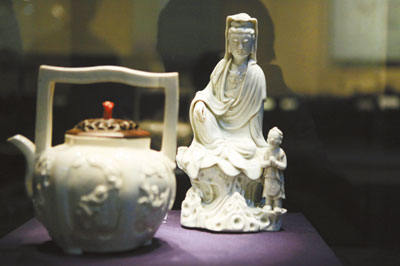
Cao Zhen caozhen0806@126.com DAZZLING porcelain and pottery relics provided by the Guangdong Museum, Hong Kong Museum of Art and Macao Museum are on display at the newly opened “Maritime Porcelain Road” exhibition at the Shenzhen Museum, presenting the glory of China’s porcelain production. The 180 exhibits are displayed in three sections, showcasing Chinese pottery and porcelain dating back to the Han Dynasty (206 B.C.-A.D. 220), Chinese made-for-export porcelain with designs commissioned by European buyers, as well as Japanese and European porcelain influenced by Chinese porcelain. Wei Jun, head of the Guangdong Museum, said that in the Qin (221-206 B.C.) and Han dynasties, silk was a main export but since the Tang Dynasty (618-907), pottery and porcelain exports surpassed silk exports, which pushed China’s maritime trade to a new peak. The maritime trade of porcelain and pottery was given such great importance by many scholars that they named the routes the Maritime Porcelain Road instead of Maritime Silk Road. “Guangzhou, Hong Kong and Macao have always played the role of a gateway linking China to the world. They were important cultural centers on the ancient Maritime Silk Road,” said Wei. According to detailed English descriptions at the exhibition, some green, ivory, blue-and-white and dark reddish brown porcelain pieces were fired and glazed in various kilns in Jiangxi, Hebei, Hunan, and Guangdong, with traditional Chinese designs like birds and flowers. Some porcelain pieces made in the late Qing Dynasty (1644-1911) were decorated with designs provided by European buyers. The resulting wares, sometimes also having well-painted Oriental designs, were shipped to Europe and, beginning in the 18th century, to North America. This type of commissioned porcelain was decorated in workshops in Guangzhou with lavish over-glazed enamel. They are highly decorative, characterized by a rich palette and magnificent gilding. To cope with the needs of the Western market, plain porcelain pieces were ordered from Jingdezhen in Jiangxi and decorated in Guangzhou before export. Many products have symbols of Western royalty and religious figures. One exhibit is a tulip vase, which has multiple square levels with spouts on each level for inserting tulips. Wei said the pyramid-shaped vases were first made in the Netherlands in the 17th century. Replicas of the original tulip vases were later made in China and were imported by the Dutch East India Company. Vases and bowls salvaged from two sunk Chinese merchant ships are also on display. The South China Sea No. 1 ship sank near Yangjiang City, Guangdong around 1127-1279 and was found in 1987. It was raised out of the sea in 2007. It is the biggest ship of its kind to be found. Since it was found in the South China Sea, the ship was named South China Sea No. 1. According to the direction of the fore, the ship was heading to Southeast Asia or the Middle East. About 4,000 artifacts, including gold, silver, copper, iron and porcelain wares, were recovered. Most artifacts were porcelain from Fujian and Jiangxi. The ship is now placed in a giant pool-type water tank called the “Crystal Palace” filled with seawater. It is estimated that there were more than 8,000 items on board and the excavation is still in progress. The Nan’ao No. 1 ship sank near the Nan’ao Island near Shantou, Guangdong between 1573 and 1620. It was discovered in 2007. With the appearance of porcelain factories in Europe in the early 18th century, the demand for the Chinese export began to diminish. By the late 19th century, competition from new European factories employing mass production took its toll. The exhibition includes Japanese Imari ware, Dutch Delft ware and German Meissen porcelain. These exhibits show off a fascinating fusion of East and West. Dates: Until Sept. 18 Hours: 10 a.m.-6 p.m., closed Mondays Venue: Shenzhen Museum, Block A, Civic Center, Futian District (福田区市民中心A区深圳博物馆新馆) Metro: Shekou or Longhua Line, Civic Center Station (市民中心站), Exit B | 
